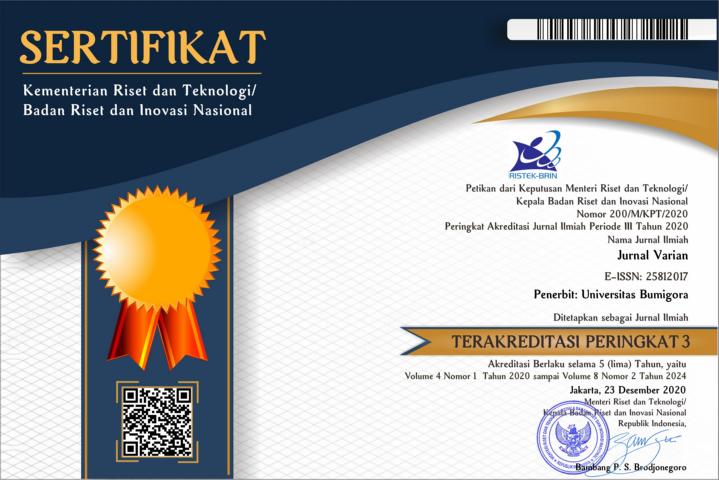Egarch Model Prediction for Sale Stock Price
Abstract
Stock is an investment in the capital market that is very promising for investors. Investors can also get high returns from the shares invested. However, this stock price is not always stable, it can go up and down drastically. The purpose of this study is to predict stock prices because they often experience instability. The method used in this research is using the Exponential generalized autoregressive conditional heteroscedasticity (EGARCH) model with the Quasi Maximum Likelihood (QML) method. The result of this research is the implementation of this model. The EGARCH model used is the stock price index model that is formed, namely the autoregressive integrated moving average (ARIMA) (0, 1, 2) EGARCH (1.4). The conclusion from the results of the research that predictions using the ARIMA model (0, 1, 2) EGARCH (1, 4) is the best model in accommodating the asymmetric nature of the volatility of the stock price index. The results of this egarch model show more optimal prediction results seen from an error of 3% compared to other modes such as the arch model and the GARCH model.
References
3(1).
Ariefianto, M. D. (2012). Ekonometrika: esensi dan aplikasi dengan menggunakan eviews.
Arikunto, S. (2019). Prosedur penelitian suatu pendekatan praktik.
Engle, R. F. (1982). Autoregressive conditional heteroscedasticity with estimates of the variance of united kingdom inflation. Econometrica: Journal of the econometric society, pages 987–1007.
Husein, I., Suhada, A., Chetthamrongchai, P., Peressypki, A. P., Nurrohkayati, A. S., Hoang Ca, V., Huynh Tan, H., Grimaldo Guerrero, J. W., and M Kavitha, M. (2021). Scheduling for a container supply chain to minimize costs using the meta-innovation
approach. Industrial Engineering and Management Systems, 20(4):662–671.
Husein, I. and Widyasari, R. (2022). Algorithm symmetric 2-dlda for recognizing handwritten capital letters. MATRIK: Jurnal
Manajemen, Teknik Informatika dan Rekayasa Komputer, 21(2):389–402.
Husein, I., Zein, A., and Sabrina, L. (2022). Mustahiq (zakat recipient) determination application with analytic hierarchy process
model. Sinkron: jurnal dan penelitian teknik informatika, 7(4):2462–2468.
Inlistya, V. A. (2017). Perbandingan Metode Antara GJR-GARCH Dan EGARCH Pada Analisis Volatilitas Indeks Saham Syariah
Indonesia. PhD thesis, Institut Teknologi Sepuluh Nopember.
Kartika, W. D. (2020). Pemodelan Exponential GARCH menggunakan metode Quasi Maximum Likelihood: Studi kasus harga saham
PT. Telkom Tbk. PhD thesis, Universitas Islam Negeri Maulana Malik Ibrahim.
Kuntoro, H. (2015). Teori dan Aplikasi Analisis Seri Waktu. Zifatama Publisher.
Nasarudin, M. I. et al. (2014). Aspek hukum pasar modal Indonesia. Kencana.
Nuryanto, N. and Pambuko, Z. B. (2018). Eviews untuk analisis ekonometrika dasar: Aplikasi dan interpretasi. UNIMMA PRESS,
pages 978–602.
Poerwanto, B. and Fajriani, F. (2020). Resilient backpropagation neural network on prediction of poverty levels in south sulawesi.
MATRIK: Jurnal Manajemen, Teknik Informatika dan Rekayasa Komputer, 20(1):11–18.
Prakoso, B. H. (2019). Implementasi support vector regression pada prediksi inflasi indeks harga konsumen. MATRIK: Jurnal
Manajemen, Teknik Informatika dan Rekayasa Komputer, 19(1):155–162.
Pratisto, A. (2004). Cara mudah mengatasi masalah statistik dan rancangan percobaan dengan spss 12. Jakarta: PT. Elex Media
Komputindo.
Rizal, A. A. and Soraya, S. (2018). Multi time steps prediction dengan recurrent neural network long short term memory. MATRIK:
Jurnal Manajemen, Teknik Informatika dan Rekayasa Komputer, 18(1):115–124.
Saida, M. D. N., Sudarno, S., and Hoyyi, A. (2016). Pemodelan return indeks harga saham gabungan menggunakan threshold
generalized autoregressive conditional heteroscedasticity (tgarch). Jurnal Gaussian, 5(3):465–474.
Samsul, M. (2006). Pasar modal dan manajemen portofolio.
Sugiyono, D. (2013). Metode penelitian pendidikan pendekatan kuantitatif, kualitatif dan r&d.
Sunariyah (2006). Pengantar Pengetahuan Pasar Modal. UPP STIM TKPN.
Wardhono, A., Indrawati, Y., Qoriah, C. G., and Nasir, M. A. (2019). Analisis data time series dalam model makroekonomi. Pustaka
Abadi.
Wibowo, N. M., Sugito, S., and Rusgiyono, A. (2017). Pemodelan return saham perbankan menggunakan exponential generalized
autoregressive conditional heteroscedasticity (egarch). Jurnal Gaussian, 6(1):91–99.
Zulfikar, S. and Si, M. (2016). Pengantar pasar modal dengan pendekatan statistika. CV Budi Utama.

This work is licensed under a Creative Commons Attribution 4.0 International License.


















